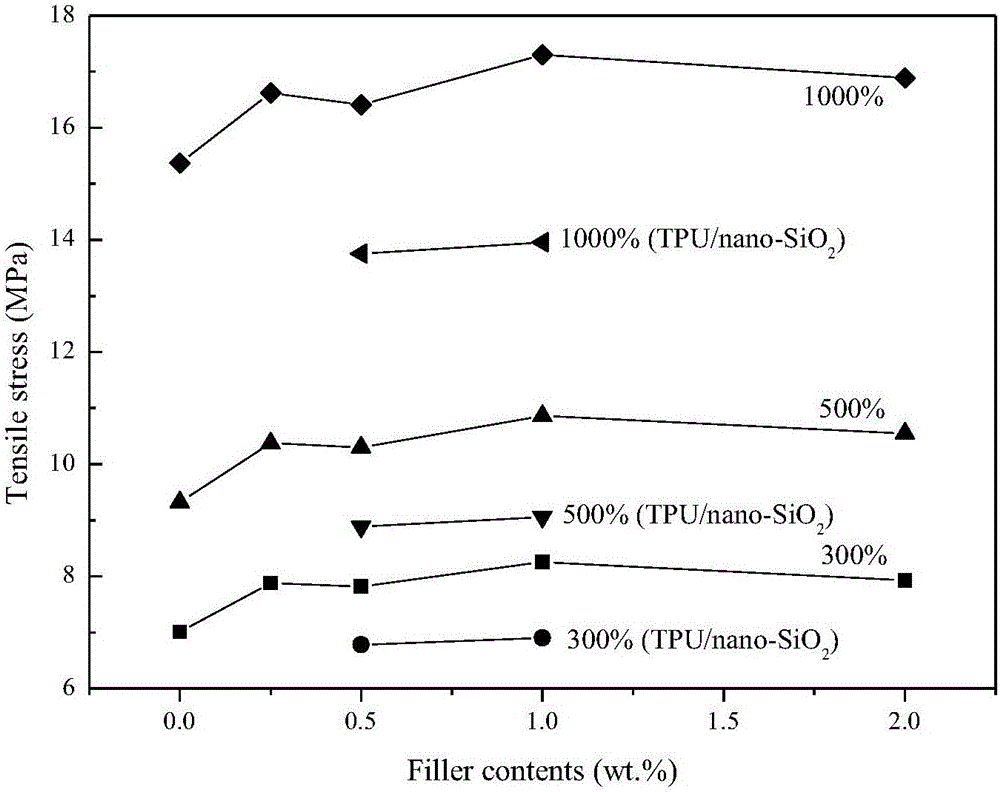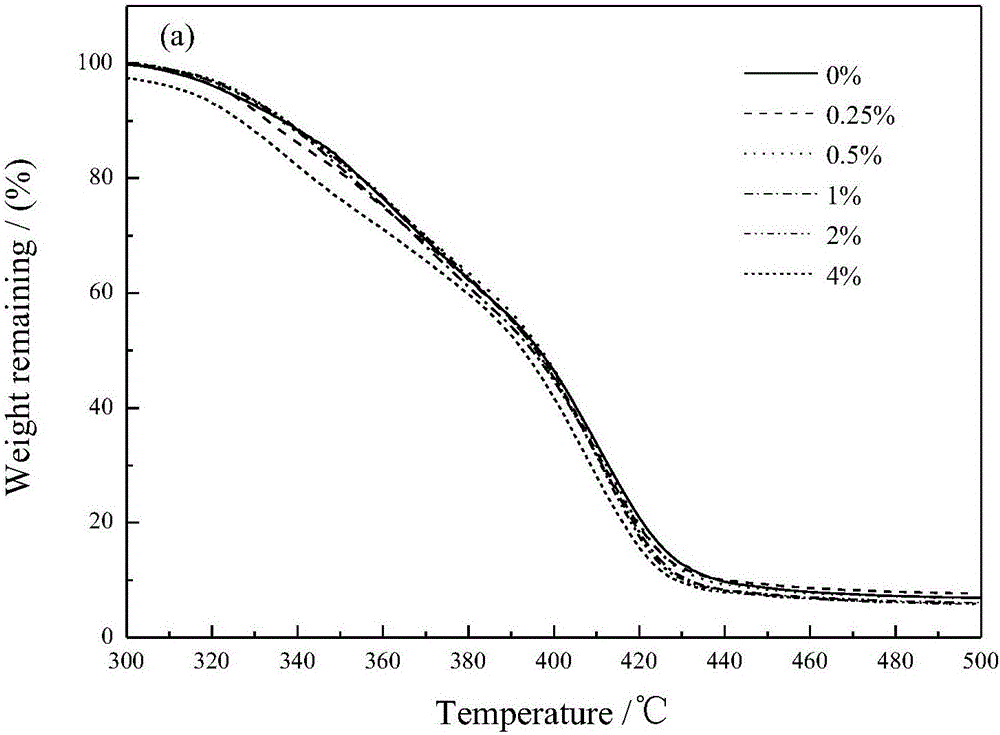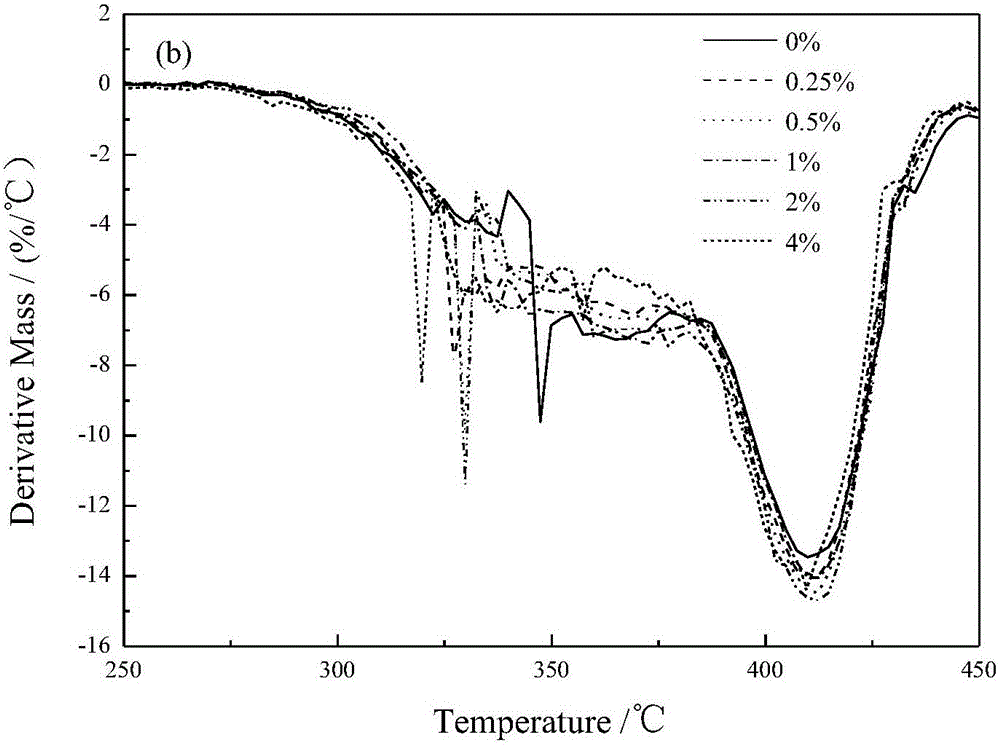Graphene-silica hybrid material and method for preparing polyurethane based nanocomposite
A nanocomposite material, silica technology, applied in the direction of nanotechnology, can solve problems such as easy agglomeration, inability to fully utilize the excellent performance of graphene, and reduce the performance of matrix resin, so as to promote dispersion, excellent mechanical properties and thermal properties, The effect of inhibiting agglomeration
- Summary
- Abstract
- Description
- Claims
- Application Information
AI Technical Summary
Problems solved by technology
Method used
Image
Examples
Embodiment 1
[0031] Preparation of graphite oxide: Add 115mL of 98% concentrated sulfuric acid into a dry beaker, cool it to below 4°C with an ice-water bath, add 5g NGP and 2.5g NaNO under vigorous stirring 3 The mixture, and then slowly add 15g KMnO 4 , and control the temperature of the reaction system below 20°C, continue to stir the reaction for 5min, then raise the system temperature to (35±3)°C, stir at constant temperature for 30min, then add 230mL of deionized water under vigorous stirring. Transfer the above system into a heated oil bath, keep the system reaction temperature at about 98°C for 15 minutes, then add 355mL hot deionized water for high-temperature hydrolysis, add 30mL H 2 o 2 Neutralize the unreacted strong oxidant, suction filter while hot, wash thoroughly with 5% hydrochloric acid and deionized water, and dry in a vacuum oven at 90°C for 24 hours to obtain graphite oxide.
[0032]Preparation of graphene-silica hybrid material: Dissolve a certain amount of silicon ...
Embodiment 2
[0041] The preparation of graphite oxide and graphene-silicon dioxide hybrid material is the same as in Example 1. During the preparation of the nanocomposite, 0.15g of graphene-silicon dioxide hybrid material and 29.85g of TPU were melt blended in the same process as in Example 1 to obtain a nanocomposite with a filler mass content of 0.5%. The test sample preparation and test conditions of the nanocomposite material are the same as in Example 1, and the tensile test results are shown in Table 1. It can be seen that compared with pure TPU, the 1000% modulus stress of the nanocomposite obtained by using the graphene-silica hybrid material is increased by 6.77%. And it is higher than the composite material obtained by using silica alone as filler under the same content.
[0042] The composition and thermal properties of the polyurethane-based nanocomposite in the present invention are as follows: Figure 2a , Figure 2b and as shown in Table 2:
[0043] Table 2 Composition ...
Embodiment 3
[0047] The preparation of graphite oxide and graphene-silicon dioxide hybrid material is the same as in Example 1. During the preparation of the nanocomposite material, 0.3 g of graphene-silica hybrid material and 29.7 g of TPU were melt blended in the same process as in Example 1 to obtain a nanocomposite material with a filler mass content of 1%. The test sample preparation and test conditions of the nanocomposite material are the same as in Example 1, and the tensile test results are shown in Table 1. It can be seen that compared with pure TPU, the 1000% modulus stress of the nanocomposite obtained by using the graphene-silica hybrid material is increased by 12.58%. And it is higher than the composite material obtained by using silica alone as filler under the same content.
[0048] The thermal performance test results are shown in Table 2. It can be seen that compared with pure TPU, the thermal properties of nanocomposites obtained by using graphene-silica hybrid materia...
PUM
 Login to View More
Login to View More Abstract
Description
Claims
Application Information
 Login to View More
Login to View More - R&D
- Intellectual Property
- Life Sciences
- Materials
- Tech Scout
- Unparalleled Data Quality
- Higher Quality Content
- 60% Fewer Hallucinations
Browse by: Latest US Patents, China's latest patents, Technical Efficacy Thesaurus, Application Domain, Technology Topic, Popular Technical Reports.
© 2025 PatSnap. All rights reserved.Legal|Privacy policy|Modern Slavery Act Transparency Statement|Sitemap|About US| Contact US: help@patsnap.com



